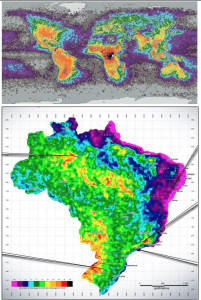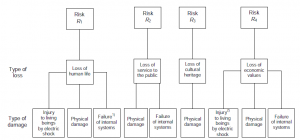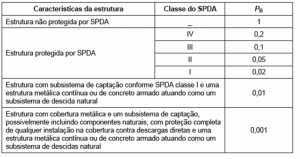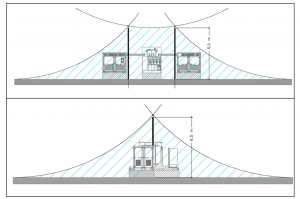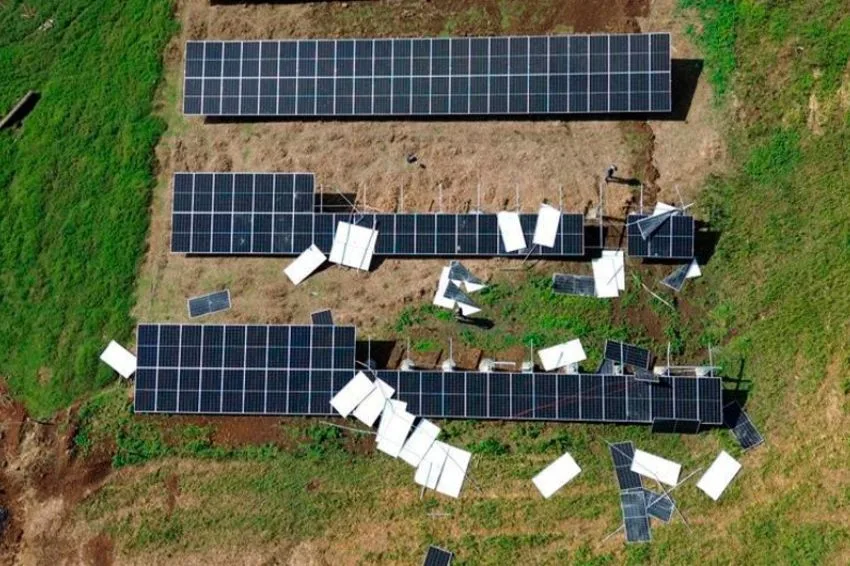Atmospheric discharges are an important risk component in any installation. Photovoltaic plants are necessarily installed outdoors, therefore exposed to direct lightning strikes.
Systems to protect structures and installations against lightning are governed by the NBR-5419 standard, which is based on IEC 62305 – Protection Against Lightning. The standard has 4 parts:
- Part 1: General principles – establishes the requirements for determining protection against atmospheric discharges;
- Part 2: Risk management – establishes the requirements for risk analysis in a structure due to atmospheric discharges to the earth;
- Part 3: Physical damage to structures and dangers to life – establishes the requirements for protecting a structure against physical damage by means of an SPDA and for protecting living beings against injury caused by touch and step voltages in the vicinity of an SPDA;
- Part 4: Internal electrical and electronic systems in the structure – provides information for the design, installation, inspection, maintenance and testing of electrical and electronic protection systems (Surge Protection Measures ─ MPS) to reduce the risk of internal damage to the structure due to electromagnetic impulses from atmospheric discharges (LEMP).
The main index for establishing the level of exposure of an installation to lightning is Ng, which is equal to the number of annual discharges to the ground (atmospheric discharges/km²/year).
Figure 1 shows the map of the Ng index, on the planet and in Brazil, where Ng varies from 1 to 20. You can see that South America stands out on the planet in terms of lightning incidence. The black areas are hot-spots – regions with a very high incidence of lightning, which occur in South America (Venezuela and Colombia) and Central Africa.
The Ng index allows the calculation of the probability of an installation being struck by lightning in a year, simply by multiplying the occupied area (in km²) by Ng (Ng x S = lightning strikes per year). A UFV GD of 5 MWp, occupying an area of 100,000 m² in a region with Ng = 10, will be exposed to the average incidence of one lightning strike per year.
Figure 2 shows the four types of risk foreseen by NBR-5419-2. The risk analysis to be carried out for a roof GFV is the same that must be carried out for the building as a whole, be it residential, commercial or industrial. All types of risk can be considered:
- R1 – loss of human life – since buildings are frequented by people who live, work or are there to provide some service;
- R2 – loss of service to the public – if the building houses a hospital, museum, telephone exchange, sheltered substation, etc.;
- R3 – loss of cultural heritage – if the building houses a museum or library, for example;
- R4 – economic losses – associated with damage to facilities and equipment and interruption of operations.
For a GFV or a ground UFV, only the assessments relating to risks R2 and R4 must be applied. Risk R1 is not applicable, due to the fact that photovoltaic arrays are outdoor installations and, therefore, cannot provide protection to people.
To control this type of risk, the availability of an approaching lightning storm alarm system is necessary, which can be local or remotely monitored, which allows teams working in the area to retreat to sheltered locations until the risk is eliminated. lightning strike no longer exists. Risk R3 is obviously not applicable.
The R4 risk is very often not considered, mainly due to a lack of sufficient information to characterize the economic loss associated with a lightning strike. What remains is R2, which can be associated with material damage to the installation and the failure of essential components for its operation, which, ultimately, will result in loss of generation, whether for the interconnected system or for the internal consumer.
Risk analysis is a complex process, which involves the selection of a wide set of parameters associated with the different aspects of the problem of a lightning strike at a facility.
The availability of software helps a lot in preparing this analysis. Taking the DEHN Risk Tool program as an example, which is one of the most complete (including a Portuguese version), the following program modules can be identified, which deal with different groups of parameters:
- dimensional aspects of the building – which, depending on the built area and height, defines the area exposed to direct lightning strikes (also considering the Ng index);
- aspects of building occupancy – which can be divided into different zones (classified according to criteria established in NBR-5419), number of people, function and type of content of the building, and values that can be associated with its content;
- power, communications and signal lines that serve the building, as well as the internal subsystems interconnected to them;
- existing grounding and lightning protection infrastructure at the installation;
- quantification of the four types of risks (R1 to R4) and associated monetary values;
- measures to be taken to reduce calculated risks to levels considered appropriate.
The probability of a discharge causing physical damage to a structure depends on the protection measures adopted, depending on the SPDA class, as established in NBR-5419-2 – Table B.2 (reproduced in Figure 3). The class of SPDA to be implemented in an installation is defined based on the risk analysis, carried out as established in Part 2 of NBR-5419.
It is worth noting that photovoltaic arrays are structures that cannot be protected from direct lightning strikes, as they are exposed to the weather. The installation of an SPDA in a ground UFV would require a greater spacing between the photovoltaic arrays, which would result in a significant reduction in the generation capacity in Wp/m², and would also result in shading of photovoltaic modules, in addition to the implementation and installation costs. system maintenance.
An intermediate solution adopted in a few projects is the use of air terminals fixed to the structures of the photovoltaic arrays. These components do not prevent rays from falling into structures, they only intercept some of the rays that could fall directly onto a module and discharge it normally into the structure of the photovoltaic array.
The design criteria for installing these components, in theory, must consider the metallic structures of the photovoltaic arrays as an immense Faraday cage, installing the air terminals at the vertices of the lattice calculated according to the SPDA class determined by the risk analysis, which will normally be II or III.
With or without the SPDA mentioned above, the photovoltaic arrays of a ground-based UFV will fall into the category of unprotected structure (Figure 3), which has a 100% probability of intercepting a ray that strikes its exposure area. It is then necessary to carry out a risk analysis of other UFV facilities – electrocenters, measuring cabins, O&M rooms, workshops, changing rooms, etc.
Figure 4 shows the SPDA of an electrocenter. The risk analysis of an electrocenter normally indicates that there is no need to install an SPDA, due to its small area and the very occasional presence of people.
In this way, the specification of lightning rods for the electrical center depends on a decision to be made with the end customer, who sometimes insists on lightning rods.
It should be noted that, with or without lightning rods, the installation of DPS in the QGBT of the electrocenter is mandatory, and its specification must be subject to an analysis that evaluates the type of UFV (with concentrated or distributed inverters), the existence of power lines low voltage power supply that leaves the electrocenter to supply external loads (CCTV cameras, RSU antennas, weather station, etc.).




